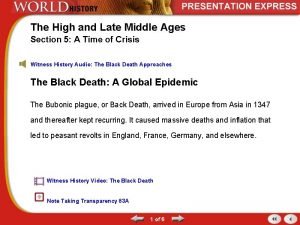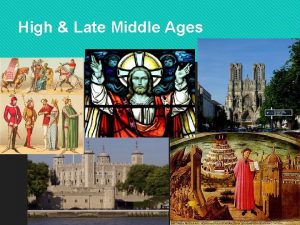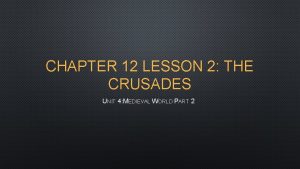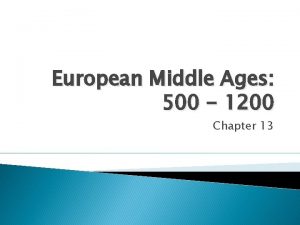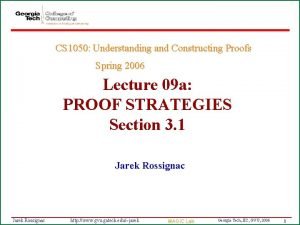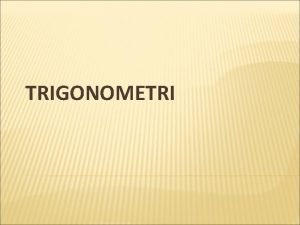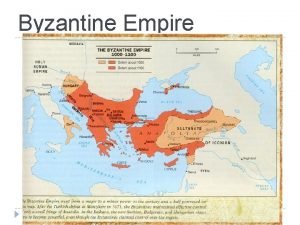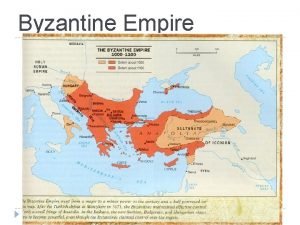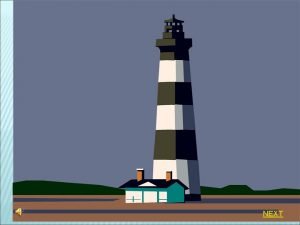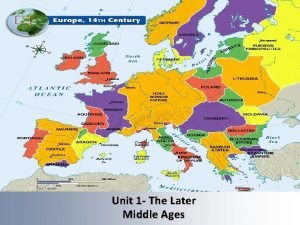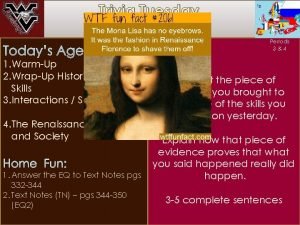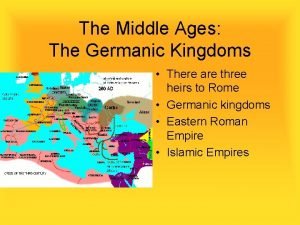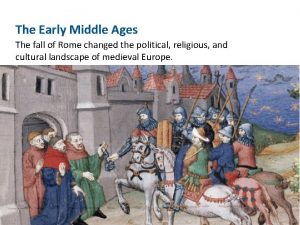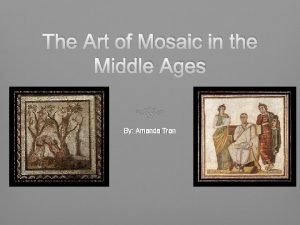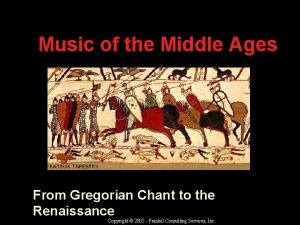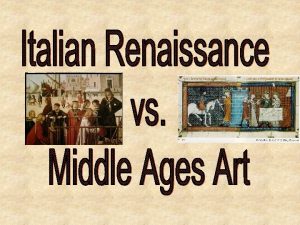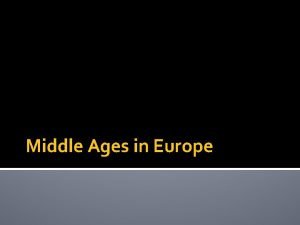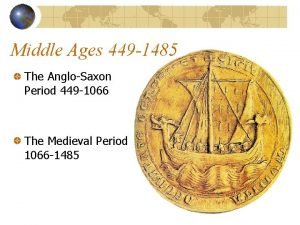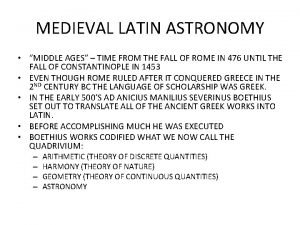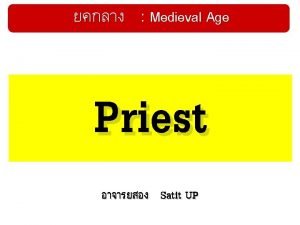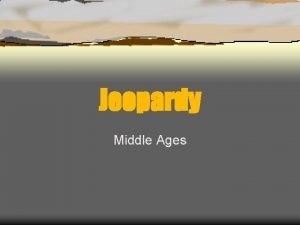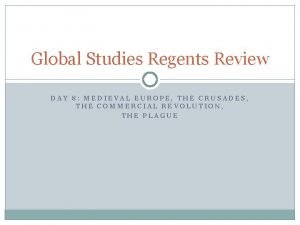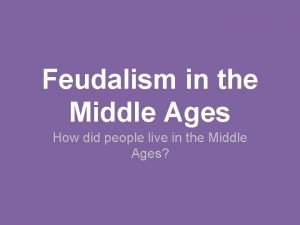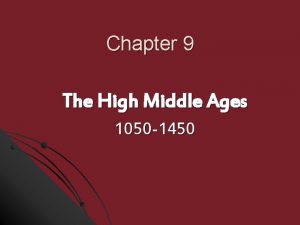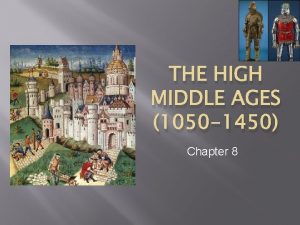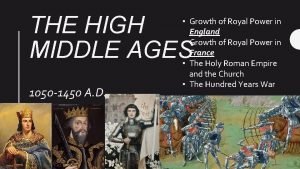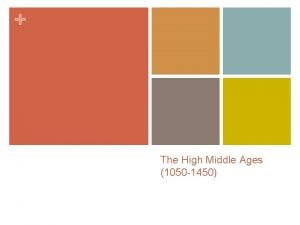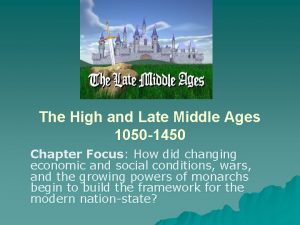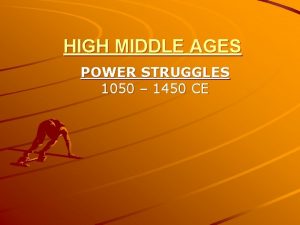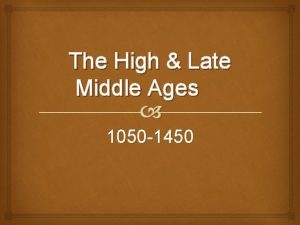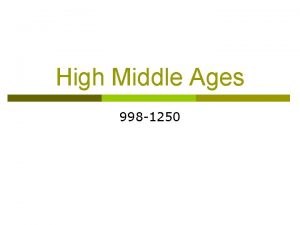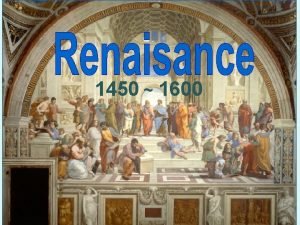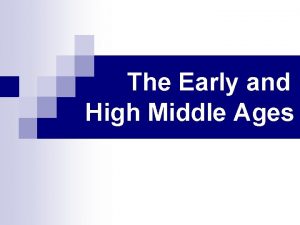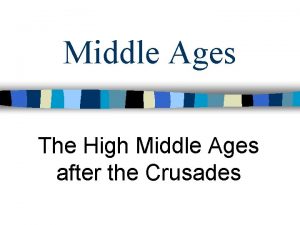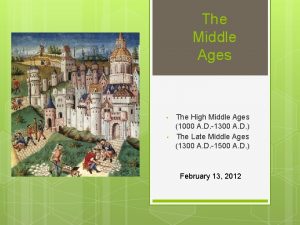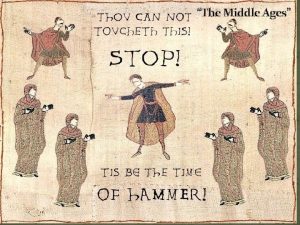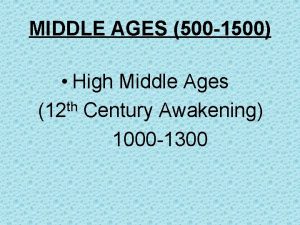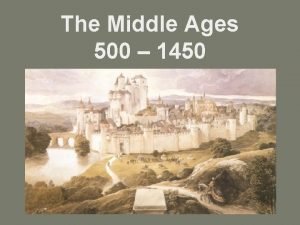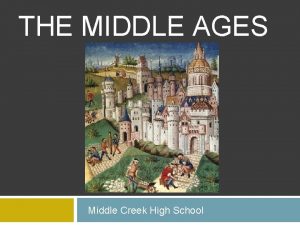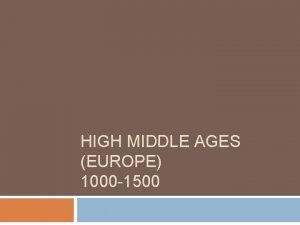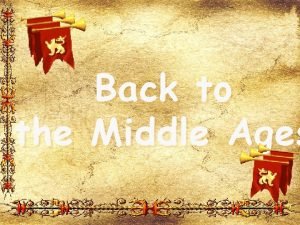Chapter 9 The High Middle Ages 1050 1450































- Slides: 31

Chapter 9 The High Middle Ages (1050– 1450)

I. Growth of Royal Power in England France

A. Monarchs, Nobles, and the Church 1. During feudal times, monarchs in Europe stood at the head of society but had limited power. Nobles and the Church had as much —or more—power than the monarchs. 2. In order to expand their power, monarchs: a. set up royal courts b. organized government bureaucracies c. developed systems of taxation d. built standing armies e. strengthened ties with the middle class 3. In this way, little by little over many centuries, these monarchs built the framework for modern-day nation states.

B. Evolution of English Government 1. 1066 - Norman Conquest = William of Normandy defeats Anglo. Saxons at Hastings. 2. 1086 - Domesday Book = William I uses this survey as a basis for taxation. 3. 1160 s– 1180 s - Common Law = Henry II lays foundation for English legal system. 4. 1215 - Magna Carta = John signs this document limiting royal power and extending rights. 5. 1295 - Model Parliament = Edward I summons Parliament, which includes representatives of common people.

C. Royal Lands in France, 987 -1328 Between 987 and 1328, the French monarchy vastly increased its royal lands.

D. Successful Monarchs in France 1. Monarchs in France did not rule over a unified kingdom. However, under strong Capetian kings, such as Philip II and Louis IX, they slowly increased royal power. a. Philip II - Granted charters to new towns. Introduced a standing army, Filled government positions with loyal middle-class officials, Introduced new national tax. Quadrupled land holdings b. Capetians - made throne hereditary, added to their lands by playing rival nobles against each other, won the support of the Church, built an effective bureaucracy c. Louis IX - Checked up on local officials, Expanded royal courts, Outlawed private wars, Ended serfdom in his lands, Left France an efficient, centralized monarchy

II. The Holy Roman Empire and the Church

A. The Holy Roman Empire 1. With secular and religious rulers advancing rival claims to power, explosive conflicts erupted between monarchs and the Church. a. After the death of Charlemagne, the Holy Roman Empire dissolved into a number of separate states. b. German emperors claimed authority over much of central and eastern Europe and parts of France and Italy. c. The hundreds of nobles and Church officials, who were the emperor’s vassals, held the real power.

B. The Struggle Over Investiture 1. The Holy Roman emperors and other monarchs often appointed the Church officials within their realm. This practice was known as lay investiture. 2. Popes, such as Gregory VII, tried to end lay investiture, which they saw as outside interference from secular rulers. 3. The struggle over investiture dragged on for almost 50 years. 4. Finally, in 1122, both sides accepted a treaty known as the Concordat of Worms. It stated that only the Church could appoint bishops, but that the emperor had the right to invest them with fiefs.

C. German Emperors in Italy 1. During the 1100 s and 1200 s, ambitious German emperors struggled with powerful popes as they tried to gain control of Italy. 2. While the emperors were involved in Italy, German nobles grew more independent. As a result, Germany did not achieve unity for another 600 years. 3. In Italy, the popes asked the French to help them overthrow the German emperors. Power struggles in Italy and Sicily led to 200 years of chaos in that region.

D. The Height of Church Power 1. “The pope stands between God and man, lower than God, but higher than men, who judges all and is judged by no one. ” —Pope Innocent III 2. Pope Innocent III claimed supremacy over all other rulers. He used the tools of excommunication and interdict to punish monarchs who challenged his power. 3. After Innocent’s death, popes continued to press their claims for supremacy. However, English and French monarchies were becoming stronger. The papacy soon entered a period of decline.

III. Europeans Look Outward

A. The World in 1050 1. ISLAMIC EMPIRE a. Islamic civilization spread from Spain to India. b. Islamic traders went as far as West Africa. 2. INDIA a. Cities thrived, despite political division. b. Hinduism and Buddhism flourished. 3. CHINA a. Culture flourished under Tang and Song dynasties. b. Chinese made advances in technology.

A. The World in 1050 4. WEST AFRICA a. The Sonike people built the great trading empire of Ghana. b. Merchants traded gold all over the world. 5. AMERICAS a. Mayas cleared rain forests to build cities. b. Native Americans in Peru built empires. 6. BYZANTINE EMPIRE a. Scholars studied Greek and Roman writings. b. Merchants mingled with traders from the Italian states.

B. Crusades, 1096– 1204 1. Between 1096 and 1204, Europe launched a series of crusades in order to regain the Holy Land

C. The Crusades 1. CAUSES: a. Turks invade Palestine and attack Christian pilgrims. b. Crusaders were motivated by religious zeal and the desire to win wealth and land. c. Pope Urban hopes to heal the schism, or split, between Roman and Byzantine churches and increase papal power. 2. EFFECTS: a. Religious hatred grows. b. Trade increases. c. Europe develops a money economy, which helps undermine serfdom. d. Power of feudal monarchs increases. e. Europeans become curious about the world.

D. Western Europe Emerges From Isolation 1. Immediate Effects a. Population growth b. End of feudalism c. Centralized monarchies d. Growth of Italian trading centers e. Increased productivity 2. Long-Term Effects a. Renaissance b. Age of Exploration c. Scientific Revolution d. Western European colonies in Asia, Africa, and the Americas

E. The Reconquista 1. The campaign to drive the Muslims from Spain became known as the Reconquista, or “reconquest. ” a. 700 s – Muslims conquered most of Spain. Christians began efforts to drive the Muslims out. b. 1300 – Christians gained control of the entire Iberian peninsula, with the exception of Grenada. c. 1469 – Isabella of Castile married Ferdinand of Aragon, uniting two powerful kingdoms. d. 1492 – Christians, under Isabella and Ferdinand, recaptured Grenada. The Reconquista was complete. e. After 1492 – Isabella ended the tradition of religious toleration established by the Muslims and launched a brutal crusade against Jews and Muslims.

IV. Learning, Literature, and the Arts

A. Medieval Universities 1. As economic and political conditions improved, the need for education expanded. a. By the 1100 s, schools to train the clergy had sprung up around the great cathedrals. Some of these cathedral schools evolved into the first universities. b. The first universities were in Salerno and Bologna in Italy, and then in Oxford and Paris. c. The curriculum covered the seven liberal arts: arithmetic, geometry, astronomy, music, grammar, rhetoric, and logic. d. Women were not allowed to attend the universities.

B. “New Learning” and Medieval Thought 1. An explosion of knowledge reached Europe in the High Middle Ages. Many of the new ideas were based on logic and reason, and posed a challenge to Christian thought, which was based on faith. 2. Christian scholars, known as scholastics, tried to resolve the conflict between faith and reason. Scholasticism used logic to support Christian beliefs. 3. The scholastic Thomas Aquinas concluded that faith and reason existed in harmony. Both led to the same truth, that God ruled over an orderly universe. 4. Science made little progress in the Middle Ages because most scholars still believed that all true knowledge must fit with Church teachings.

C. Literature, Architecture, and Art 1. As economic and political conditions improved, Europeans made notable achievements in literature and the arts. a. LITERATURE - New writings in the vernacular, or language of everyday people, captured the spirit of the times. The epic Song of Roland (France), Dante’s Divine Comedy (Italy), Chaucer’s Canterbury Tales (England) b. ARCHITECTURE - Towering stone cathedrals symbolized wealth and religious devotion. The Romanesque style reflected Roman influences. The Gothic Style was characterized by flying buttresses, or stone supports that stood outside the church. c. ART - Sculptors portrayed religious themes. Stained-glass windows added to the splendor of Gothic churches. The Gothic style was applied to painting and illumination, the artistic decoration of books.

V. A Time of Crisis

A. Spread of the Black Death 1. By 1347, the bubonic plague had spread to Europe. Before it had finished taking its toll, one in three Europeans had died.

B. The Black Death Caused Social Decline. 1. Social Effects: a. Some people turned to magic and witchcraft for cures. b. Others believed they were being punished by God. c. Some people turned to wild pleasure, believing the end was inevitable. d. Normal life broke down. e. Individuals turned away from neighbors and relatives to avoid contagion. f. Christians blamed and persecuted Jews.

C. The Black Death Caused Economic Decline. 1. Economic Effects: a. As workers died, production declined. b. Surviving workers demanded higher wages. As the cost of labor soared, inflation, or rising prices, broke out. c. Landowners abandoned farming, forcing villagers to look for work in the towns. d. Unable to find work, peasants revolted.

D. Upheaval in the Church 1. The late Middle Ages brought spiritual crisis, scandal, and division to the Roman Catholic Church. a. b. c. d. e. f. Many priests and monks died during the plague. Plague survivors questioned why God had spared some and killed others. The Church could not provide strong leadership in desperate times. The papal court was moved to Avignon, during a period known as the Babylonian Captivity. Popes lived in luxury. Popular preachers challenged the power of the Church.

E. Hundred Years’ War, 1337– 1453 1. 1. Between 1337 and 1453, England France fought a series of conflicts, known as the Hundred Years’ War. 2. It actually lasted 115 years!

F. Causes of The Hundred Years’ War 1. English rulers wanted to keep the French lands of their Norman ancestors. 2. French kings wanted to extend their own power in France. 3. In 1337, Edward III claimed the French crown. 4. Once fighting started, economic rivalry and a growing sense of national pride made it difficult for either side to give up.

G. Effects of The Hundred Years’ War 1. In France, national feeling grew and kings expanded their power. 2. In England, Parliament gained the “power of the purse, ” and kings began looking at trading ventures overseas. 3. The longbow and cannon made soldiers more important and knights less valuable. 4. Castles and knights became obsolete. 5. Monarchs came to need large armies instead of feudal vassals.

H. Turning Points of the Hundred Years’ War 1. Longbow - During the early years of the war, English armies equipped with the longbow overpowered their French counterparts equipped with the crossbow. An English archer could shoot three arrows in the time it took a French archer to shoot one. 2. Joan of Arc - From 1429 to 1431, Joan’s successes in battle rallied the French forces to victory. French armies continued to win even after she was executed by the English. 3. Cannon - The cannon helped the French to capture English-held castles and defeat England’s armies. French cannons were instrumental in defeating English forces in Normandy.
 Dark ages def
Dark ages def Dark ages vs middle ages
Dark ages vs middle ages The high and late middle ages section 5 quiz
The high and late middle ages section 5 quiz High to late middle ages
High to late middle ages High middle ages
High middle ages Chapter 12 lesson 2 world history
Chapter 12 lesson 2 world history Medieval hierarchy
Medieval hierarchy Sahih muslim 1050
Sahih muslim 1050 Cisc 1050
Cisc 1050 Kennel dossodossi
Kennel dossodossi Cs 1050
Cs 1050 Diketahui sin a=0 6 dan a sudut lancip maka cos a adalah
Diketahui sin a=0 6 dan a sudut lancip maka cos a adalah Math 1050 mortgage project
Math 1050 mortgage project Byzantine empire 1050
Byzantine empire 1050 Accomplishments of the byzantine empire
Accomplishments of the byzantine empire Bentuk sederhana dari 315∶180
Bentuk sederhana dari 315∶180 Map of europe in middle ages
Map of europe in middle ages Renaissance vs middle ages
Renaissance vs middle ages Germanic kingdom
Germanic kingdom Egyptian period flower arrangements
Egyptian period flower arrangements Early middle ages
Early middle ages Mosaic art in medieval period
Mosaic art in medieval period Late middle ages timeline
Late middle ages timeline Gregorian chant middle ages
Gregorian chant middle ages Dark ages vs renaissance
Dark ages vs renaissance Manorialism def
Manorialism def Middle ages description
Middle ages description Astronomy in medieval times
Astronomy in medieval times Catholic clergy hierarchy
Catholic clergy hierarchy Middle ages jeopardy
Middle ages jeopardy What were two indirect results of the crusades
What were two indirect results of the crusades Feudal system in the middle ages
Feudal system in the middle ages


